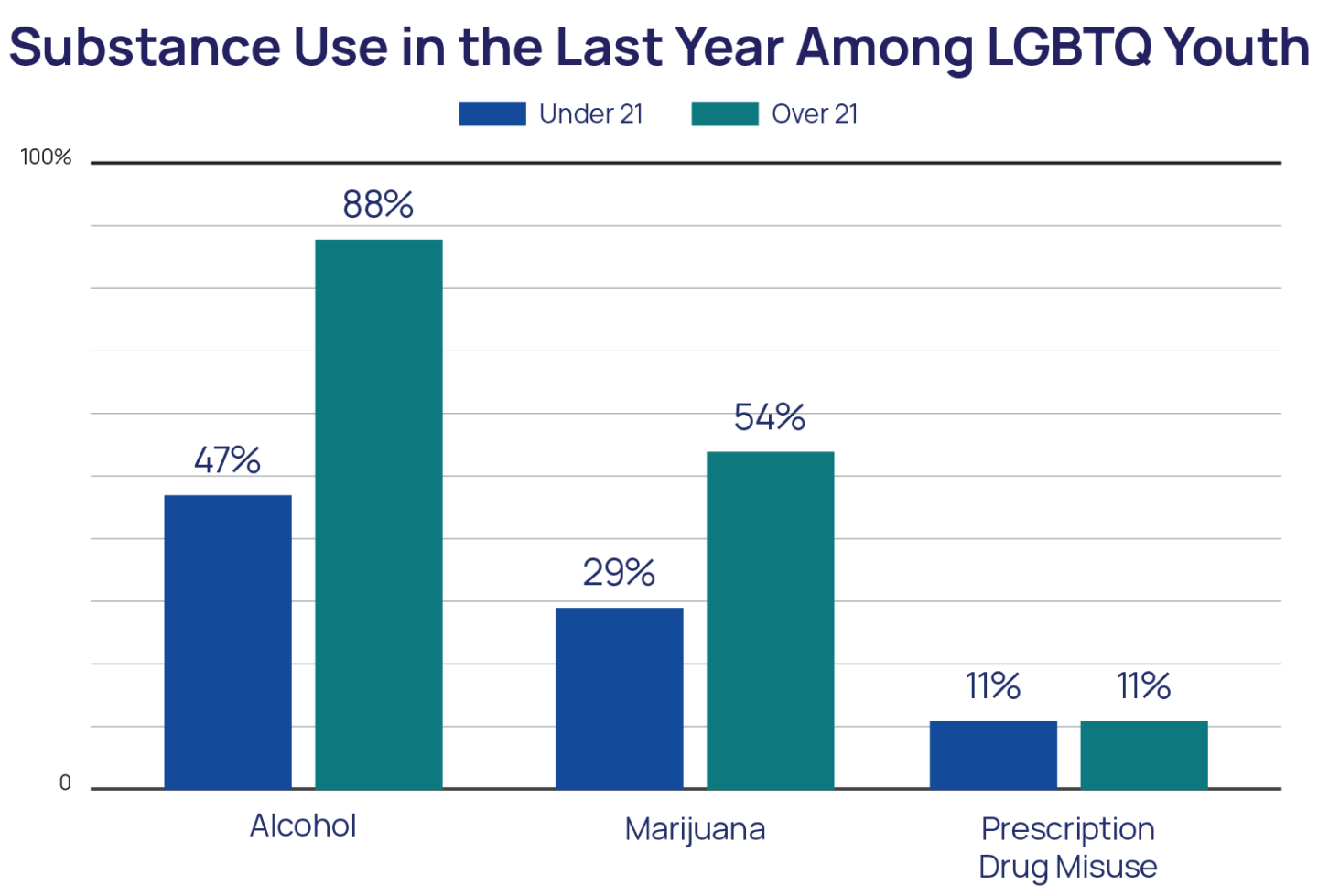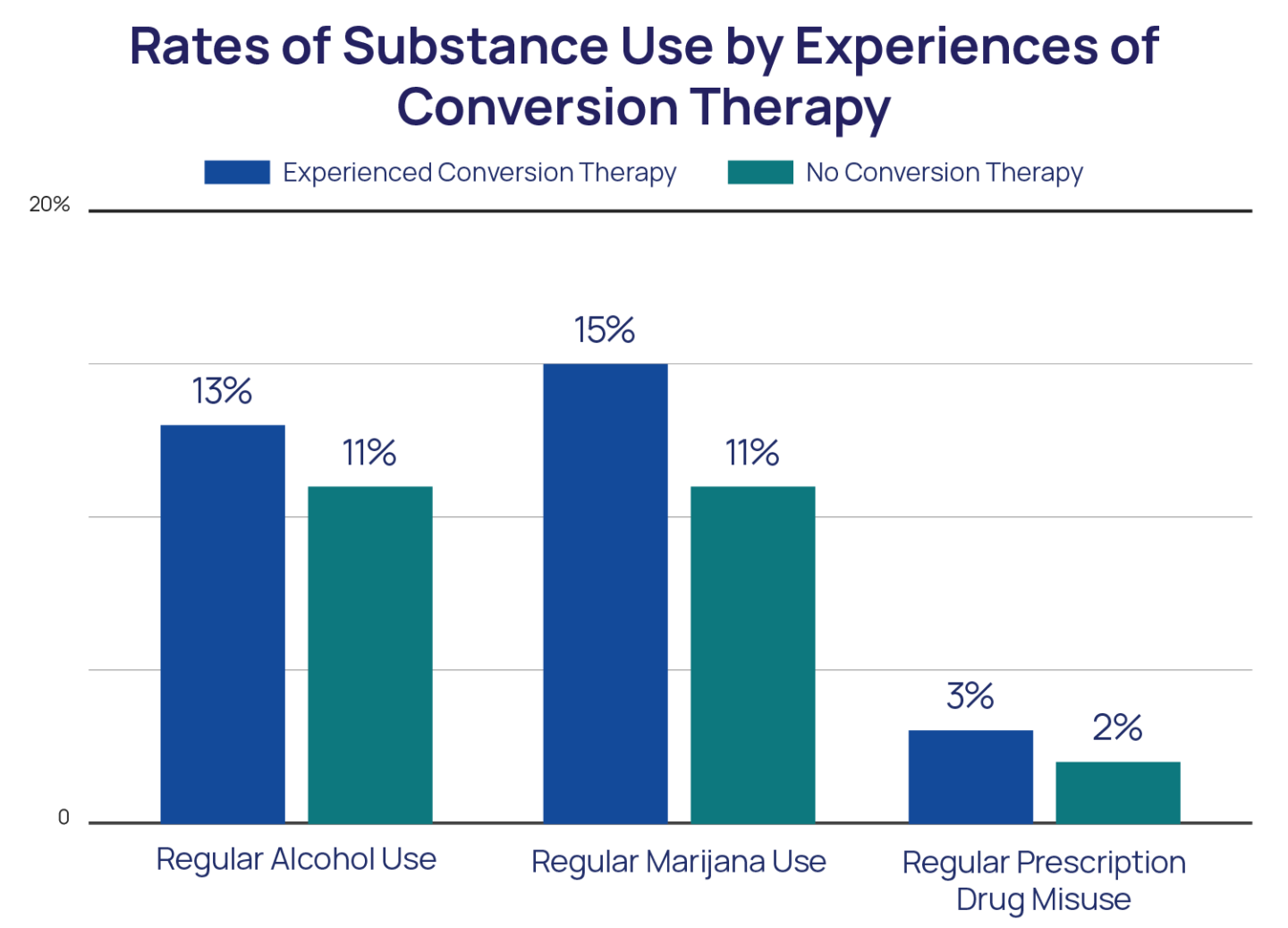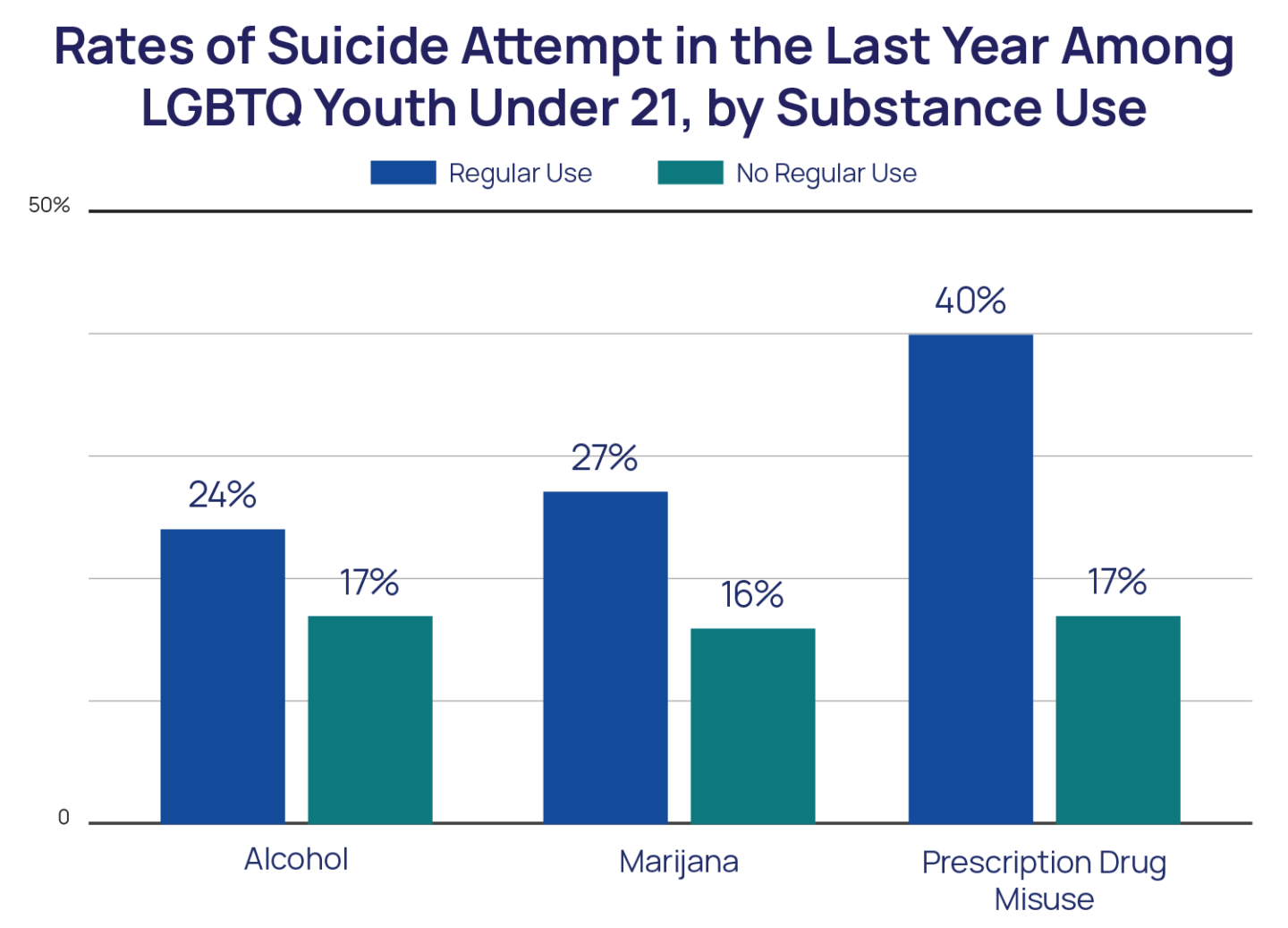Background
Both rates of substance use and suicide deaths have increased in the United States over the last ten years, especially among youth and young adults (Curtin & Heron, 2019; Gomes, Tadrous, Mamdani, & Juurlink, 2018; Hingson, Zha, & Smyth, 2019). Those with substance use disorder are at seven times greater odds of dying by suicide, compared to those who do not have a substance use disorder (Conner et al., 2019). National prevalence data on substance use among lesbian, gay, and bisexual (LGB) high school students indicate that LGB students use substances at significantly higher rates than their straight peers (Jones et al., 2020). This risk is compounded by LGB youths’ increased risk of attempting suicide compared to their straight, cisgender peers (Johns et al., 2019; Johns et al., 2020). Given that most previous research on youth substance use relies on federal datasets that have not measured gender identity in ways that include transgender or nonbinary youth, there is little research on transgender and nonbinary youths’ substance use. Using data from The Trevor Project’s 2021 National Survey on LGBTQ Youth Mental Health, this brief examines the relationship between lesbian, gay, bisexual, transgender, and queer or questioning (LGBTQ) youths’ substance use and their risk of suicide.
Results
Over half of LGBTQ youth (56%) used alcohol in the last year, including 47% of LGBTQ youth under the age of 21. Over one in three LGBTQ youth (34%) used marijuana in the last year, including 29% of LGBTQ youth under the age of 21. One in 10 (11%) LGBTQ youth reported having used a prescription drug that was not prescribed to them in the last year, and this rate was the same for those under and over the age of 21.

11% of LGBTQ youth reported regular use (defined as daily or weekly use) of both alcohol or marijuana. Rates of regular alcohol or marijuana use were much higher for LGBTQ young adults ages 21 or older than they were for LGBTQ youth under age 21. One in three LGBTQ young adults ages 21 or older (33%) reported regular alcohol use, compared to 5% of LGBTQ youth under age 21. One in five LGBTQ young adults ages 21 or older (21%) reported regular marijuana use, compared to 9% under age 21. Regular misuse of prescription drugs that were not prescribed was infrequent (2%) and did not differ by age.
Rates of substance use varied based on youths’ demographic characteristics. White cisgender boys and men had higher rates of regular alcohol (20%) use than all other LGBTQ youth (9%). Compared to White LGBTQ youth, Native/Indigenous LGBTQ youth had greater odds of reporting regular marijuana use (aOR = 1.29). Both Native/Indigenous (aOR = 2.44) and Multiracial LGBTQ youth (aOR = 1.36) had greater odds of reporting regular prescription drug misuse compared to White LGBTQ youth. In terms of gender, the only youth who had higher rates of regular marijuana use compared to cisgender males were nonbinary youth who were assigned male at birth (aOR = 1.27).

Experiencing “conversion therapy,” or efforts to change a youth’s LGBTQ identity to straight and/or cisgender, was associated with greater odds of reporting regular alcohol use (aOR = 1.24), regular marijuana use (aOR = 1.25), and regular prescription drug misuse (aOR = 1.88). Further, experiencing physical harm due to one’s LGBTQ identity was associated with greater odds of reporting regular alcohol use (aOR = 1.34), regular marijuana use (aOR = 1.62), and nearly two times greater odds of regular prescription drug misuse (aOR = 1.98).
Regular prescription drug misuse was associated with nearly three times greater odds of attempting suicide in the last year among both LGBTQ youth under age 21 (aOR = 2.98) and LGBTQ youth ages 21 or older (aOR = 2.83). Among LGBTQ youth under the age of 21, regular alcohol use was associated with nearly 50% greater odds of attempting suicide (aOR = 1.62) in the last year. Regular alcohol use among LGBTQ young people ages 21 or older was also significantly associated with attempting suicide (aOR = 1.31) in the last year. Regular marijuana use was associated with greater odds of attempting suicide in the last year both among LGBTQ youth under the age of 21 (aOR = 1.67) and among those ages 21 or older (aOR = 1.67).

Methods
Data were collected from an online survey conducted between October and December of 2020 of 34,759 LGBTQ youth recruited via targeted ads on social media. To determine the frequency of substance use, youth were asked, “In the past year how often have you used alcohol?”, “In the past year how often have you used marijuana?”, and “In the past year how often have you taken a prescription drug (such as OxyContin, Percocet, Vicodin, codeine, Adderall, Ritalin, or Xanax) without a doctor’s prescription?” Response options for all three questions included: 1) Never, 2) Once or twice, 3) Monthly, 4) Weekly, and 5) Daily or almost daily. For this brief, regular substance use was defined as reporting daily or weekly use. The question that assessed past-year suicide attempts (“During the past 12 months, how many times did you actually attempt suicide?”) was taken from the Centers for Disease Control and Prevention’s Youth Risk Behavior Survey. Adjusted logistic regression models controlled for race/ethnicity, sex assigned at birth, gender identity, sexual identity, and socioeconomic status.
Looking Ahead
These data show that substance use is common among LGBTQ youth, with over half of the respondents having used alcohol and a third having used marijuana in the last year, both of which are higher than rates among the general population of US high school students (Johns et al., 2020). Regular (daily or weekly) substance use is less prevalent but still common among LGBTQ young adults over the age of 21. Regular substance use was reported more among LGBTQ youth who had experienced efforts to change their sexual orientation and/or gender identity, and among those who had experienced physical harm due to their LGBTQ identity. These findings indicate that LGBTQ youth may use substances to cope with minority stress and negative experiences in unsupportive, anti-LGBTQ environments. Regular alcohol, marijuana, or prescription drug misuse were associated with greater odds of reporting a suicide attempt, particularly among LGBTQ youth under the age of 21. Our survey did not distinguish between marijuana use that was prescribed by a doctor and use that was not, so it is important to note that some youth over the age of 18 in our sample may be using marijuana as prescribed. Given the upheavals and social isolation that youth have experienced during the COVID-19 pandemic, it is imperative that all LGBTQ youth have access to high-quality, LGBTQ culturally competent mental health care and substance use treatment. Given the long-term negative effects of early substance use, enhanced screening and prevention services that are specific to the needs of youth, including those who are LGBTQ, should be implemented. Further, federal surveys seeking to establish the prevalence of substance use and abuse among U.S. youth must also include items specific to transgender and nonbinary identities in order to accurately capture the scope of the problem among all LGBTQ youth.
The Trevor Project is dedicated to supporting LGBTQ youth who may find themselves confronting mental health and substance use challenges. We are further committed to bringing awareness to the unique needs of LGBTQ youth as they pertain to risk factors for substance use. Our Crisis Services are available 24/7 to any LGBTQ youth in need, and our Advocacy Team continues to advocate for inclusive suicide prevention programming and behavioral health supports in schools across the U.S. Finally, our Research Team will continue to explore risks and protective factors among LGBTQ youth to further understand and help prevent suicide among this group.
References
- Conner, K. R., Bridge, J. A., Davidson, D. J., Pilcher, C., & Brent, D. A. (2019). Metaanalysis of mood and substance use disorders in proximal risk for suicide deaths. Suicide and Life‐Threatening Behavior, 49(1), 278-292
- Curtin, S. C., & Heron, M. P. (2019). Death rates due to suicide and homicide among persons aged 10–24: United States, 2000–2017. NCHS Data Brief, No. 352. Washington DC, Center for Disease Control and Prevention, National Center for Health Statistics.
- Gomes, T., Tadrous, M., Mamdani, M. M., Paterson, J. M., & Juurlink, D. N. (2018). The burden of opioid-related mortality in the United States. JAMA Network Open, 1(2), e180217-e180217.
- Grant, B. F., Saha, T. D., Ruan, W. J., Goldstein, R. B., Chou, S. P., Jung, J., … & Hasin, D. S. (2016). Epidemiology of DSM-5 drug use disorder: Results from the National Epidemiologic Survey on Alcohol and Related Conditions–III. JAMA Psychiatry, 73(1), 39-47.
- Hingson, R., Zha, W., & Smyth, D. (2017). Magnitude and trends in heavy episodic drinking, alcohol-impaired driving, and alcohol-related mortality and overdose hospitalizations among emerging adults of college ages 18–24 in the United States, 1998–2014. Journal of Studies on Alcohol and Drugs, 78(4), 540-548.
- Johns, M. M., Lowry, R., Andrzejewski, J., Barrios, L. C., Zewditu, D., McManus, T., et al. (2019). Transgender identity and experiences of violence victimization, substance use, suicide risk, and sexual risk behaviors among high school student–19 states and large urban school districts, 2017. MMWR, 68(3), 65-71.
- Johns M. M., Lowry R., Haderxhanaj L. T., et al. (2020). Trends in violence victimization and suicide risk by sexual identity among high school students — Youth Risk Behavior Survey, United States, 2015–2019. MMWR Suppl, 69,(Suppl-1):19–27.
- Jones, C. M., Clayton, H. B., Deputy, N. P., Roehler, D. R., Ko, J. Y., Esser, M. B., … & Hertz, M. F. (2020). Prescription opioid misuse and use of alcohol and other substances among high school students—Youth Risk Behavior Survey, United States, 2019. MMWR Supplements, 69(1), 38.
For more information please contact: [email protected]